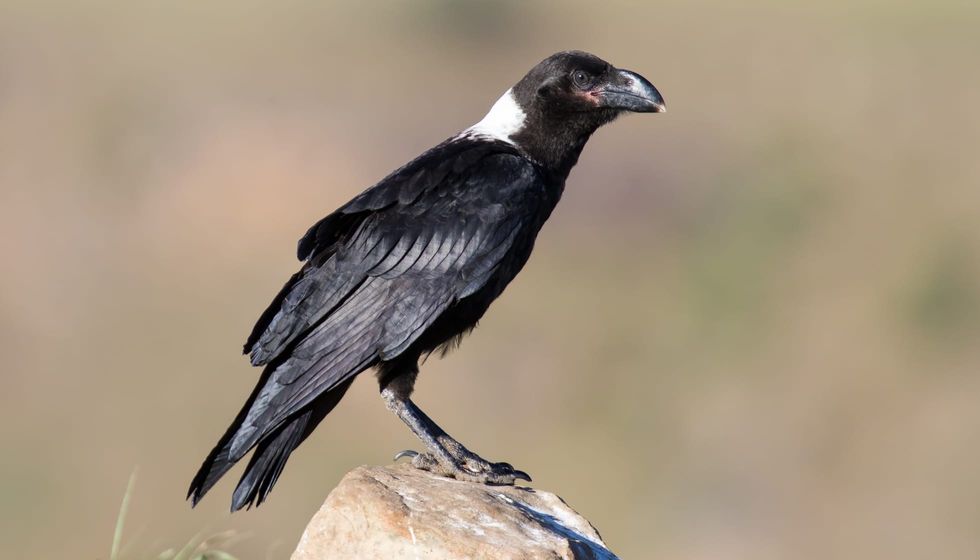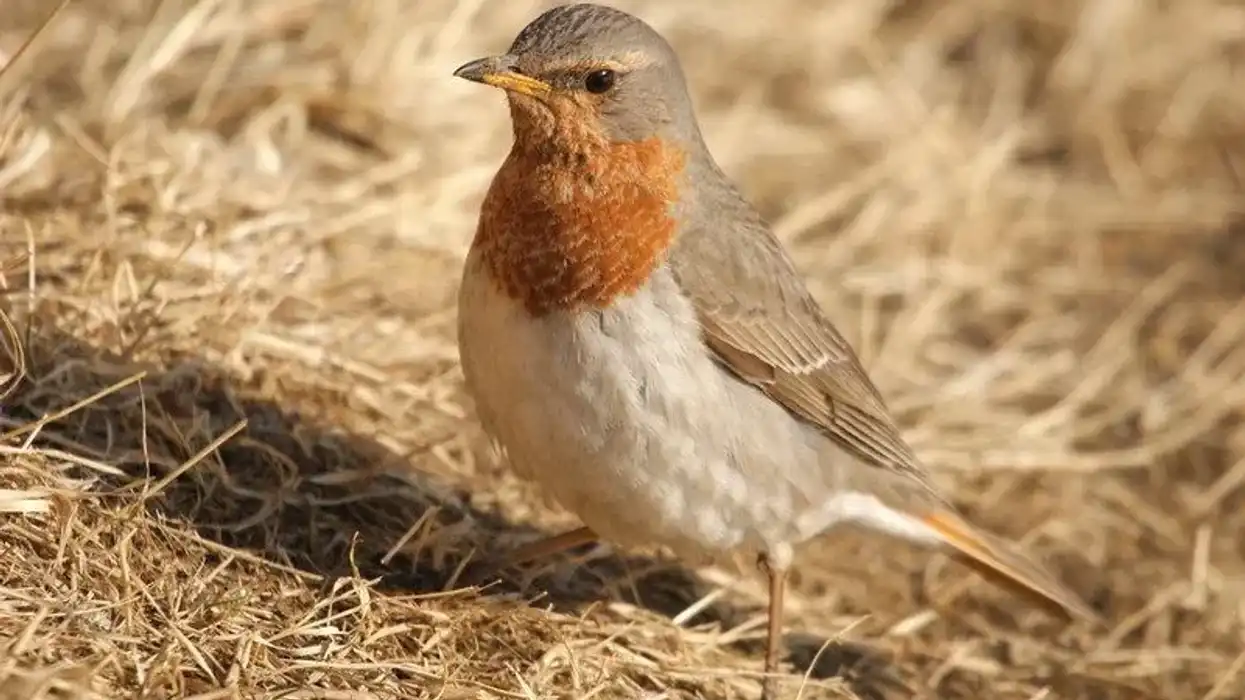The white-necked raven (Corvus albicollis) is a type of raven species native to Southern and Eastern Africa. They are part of the Corvidae family.
They are about 19-21 in (50- 55 cm) long and weigh about 1.6-1.9 lb (760-860 g). They are a bit smaller than the common raven and the thick-billed raven who are their closest relatives. The white-necked ravens get their names from the big patch of white feathers that they have on the back of their necks.
They also have a deep bill that has a white tip. The rest of their bodies are black.
They like to keep their distance from humans and can be found nesting in mountainous areas. They also scavenge in the city and forage in the wild.
They live off of the carrion of roadkill, but they also eat small lizards and insects. They are omnivorous birds that also eat grains, seeds, and vegetables. They mostly feed on the ground but sometimes in trees.
They have a throaty croak with a whispering note. In captivity, they have also been known to mimic other sounds.
If you want to read more animal articles, check out the Hawaiian crow and the common raven.
White Necked Raven Interesting Facts
What type of animal is a white-necked raven?
The white-necked raven (Corvus albicollis) is a type of bird belonging to the Corvus genus. Meaning they are a type of raven, but slightly smaller than the common raven. They are also a little smaller than their closest relative, the thick-billed raven. The white patch on their neck is also more extensive than on the thick-billed ravens.
What class of animal does a white-necked raven belong to?
The white-necked raven (Corvus albicollis) belongs to the Aves class of the Animalia kingdom. They belong to the Corvidae family.
How many white-necked ravens are there in the world?
The exact number of the white-necked raven (Corvus albicollis) in the world is unknown. However, they are listed as of Least Concern on the IUCN Red List and have a large population.
Where does a white-necked raven live?
The white-necked raven is found in Eastern and Southern Africa. They inhabit open, mountainous places.
What is a white-necked raven's habitat?
This bird is mostly seen in the mountainous and hilly areas of Eastern and Southern Africa. They nest away from human populations, mostly in cliffs, mountains, and hilly towns. The white-necked raven does not live with people in the wild but might visit towns and villages for scavenging. They also forage in forests.
Who do white-necked ravens live with?
The white-necked raven likes to stay away from people. They are only known to visit towns and villages for scavenging. They do not live in big groups and, like other ravens, they are thought to mate for life.
How long does a white-necked raven live?
In the wild, white-necked ravens can live up to 25-50 years.
How do they reproduce?
Not much information is available on the mating habits of the white-necked raven, but we know that they usually nest away from human populations on cliff ledges. They also lay about three to five eggs in one clutch. If the mating habit of other ravens is anything to go by, then this bird also mates for life.
What is their conservation status?
They are listed as of Least Concern on the IUCN Red List, but their population is decreasing. The exact number of white-necked ravens in the world is unknown.
White Necked Raven Fun Facts
What do white-necked ravens look like?

The white-necked raven is a type of bird belonging to the Corvidae family, belonging to the Corvidae family and Corvus genus means they are a type of raven. The average length of the adult white-necked raven is about 19-21 in (50- 55 cm) and their weight is about 1.6-1.9 lb (760-860 g).
Their length is smaller than both the common raven and the thick-billed raven, which is their closest relative. Their wingspan is about 30-34 in (75-85 cm).
The bird has a black body with a white tuft of feathers adorning their necks, which earned them their names. The white patch on this bird is bigger and more prominent than the white patch on the neck of the thick-billed raven.
Not only that but their bill also has a white tip. Otherwise, they have a black feather-covered body.
The feathers on their neck, chest, and throat have a glossy purple shine. Their tails are also shorter in length than the common raven, although they have a deeper bill.
How cute are they?
Ravens are considered to be beautiful but dangerous birds. Many perceive them to be bad omens. They might not be the cutest birds but they are definitely beautiful and regal.
How do they communicate?
White-necked ravens are described as having a sore throat. They vocalize to communicate but their voice is more throaty and breathy compared to other ravens. They have a huskier note in their croaks. They are also capable of mimicking sounds but that is only observed in birds in captivity.
How big is a white-necked raven?
The average length of a white-necked raven is about 19-21 in (50- 55 cm). They are medium-sized birds. These birds are smaller in size than the common raven. They are also slightly smaller than the thick-billed raven that is their nearest relative, but the white patch on their neck is bigger than that of the thick-billed raven.
How fast can a white-necked raven fly?
The exact speed of the white-necked raven's flight is unknown. However, all ravens are great fliers and can fly at a speed of about 30 mph (50 kph).
How much does a white-necked raven weigh?
The average weight of adult white-necked ravens is about 1.6-1.9 lb (760-860 g).
What are their male and female names of the species?
There are no specific names for the males and females of the species. They are simply called the male white-necked raven and the female white-necked raven.
What would you call a baby white-necked raven?
There are no specific names for baby white-necked ravens, but like most birds, they can be referred to as chicks.
What do they eat?
The white-necked raven is mostly known to feed on the ground. They mostly feed on roadkill carrion, but sometimes they also eat live food like insects and small reptiles.
They also eat grains and seeds. These smart birds are also known to drop small tortoises on the ground from a height to break their shells and eat them. Like most crows and ravens, they are also omnivorous.
Are they dangerous?
Like the other birds of the Corvus genus, white-necked ravens are also slightly dangerous when attacked or threatened. Much like the common raven, these birds can also be very possessive of their young and try to attack anything that threatens their babies and their nest.
It attacks predators with its large bill and is usually successful at driving them away.
They may also attack humans if they get very close to their nests but there had been no account of serious injuries from a raven attack.
The bill can cause some harm but not too much. So it can be said that if you avoid attacking them or going too close to their nests, you have no reason to fear these birds.
Would they make a good pet?
It is not legal to keep wild birds as pets. This means you cannot legally capture a white-necked raven, but these birds, much like the common raven are very smart and can remember people who are kind to them. So if you feed them regularly, they might come back and hang out with you from time to time.
Did you know...
The white-necked raven is larger than the pied crow, but the white patch on pied crows also extends to their breasts whereas the white-necked raven only has a patch on their neck.
Is a raven smarter than a crow?
Both ravens and crows belong to the Corvus genus along with jays, magpies, and some other birds. The Corvus birds are probably the most intelligent birds in the world, but crows and ravens are a league of their own.
They are both extremely smart birds, but the ravens might be a tad bit smarter than crows.
Not only can ravens mimic the sounds of other birds, but they can also play tricks and even seem to remember faces. Research says that their brains seem to work at the same level as a seven-year-old human child.
What's the difference between a crow and a raven?
Ravens have a larger bill than crows.
Ravens are also much bigger in size than normal crows. A crow is about the size of a pigeon whereas ravens can be the size of red-tailed hawks.
Ravens also have a different tail shape and flight pattern to crows. Crows have fan-shaped tails, wherein the raven's tail is wedge-shaped.
Most ravens have a dark, black body and this black covers the entirety of their bodies. Whereas crows have a lighter grey underbelly and throat.
Ravens also soar for longer than crows.
Here at Kidadl, we have carefully created lots of interesting family-friendly animal facts for everyone to discover! Learn more about some other birds including the dodo and the hoopoe.
You can even occupy yourself at home by drawing one of our white necked raven coloring pages.










